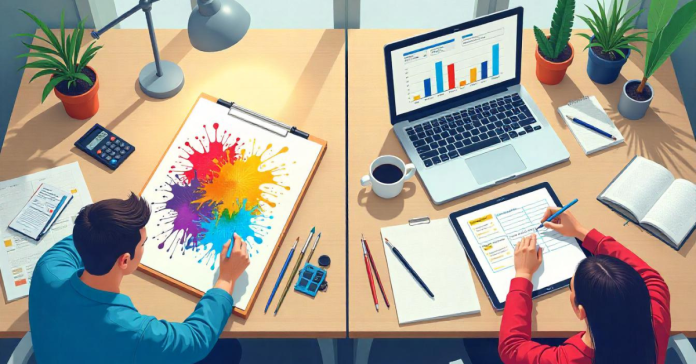Let’s face it – trying to balance creativity and business is like attempting to paint a masterpiece while simultaneously filing your taxes. Most artists would rather eat expired paint than deal with spreadsheets, yet here we are, living in a world where even Picasso would need to understand NFTs.
The Great Artistic Tightrope Walk
Have you ever come across those artists who cannot even manage their personal finances and, therefore do not know how to handle an artwork so that it will sell well too? The tension between having a pure artist within and being able to pay the bills is as eternal as the Neanderthal ‘painter’ skating on the thin ice of attempting to sell the picture of a mammoth.
When Art Meets Accounting
Remember when Banksy’s artwork shredded itself right after selling for over a million dollars? That’s one way to balance creativity and business – literally destroying the commodity while creating something even more valuable. Talk about having your cake and eating it too.
The Money-Art Matrix
Here is the truth, people wanna practice creativity, and produce fantastic pieces they want to get profit from it but they don’t know how to market it. Let’s compare it to hamburger – an artist inside of you wants to add truffles and gold foils to it, while a businessman understands that, despite their exotic appeal, ordinary mayonnaise and ketchup will always be popular.
Price Tags and Paintbrushes
Take Yayoi Kusama – she turned her obsession with polka dots into a global empire. She didn’t compromise her vision; she just figured out how to make it marketable. That’s the secret sauce of balancing creativity and business – finding where your weird meets the world’s wallets.
The Creative Compromise (That Isn’t Really)
Hey, no one wanted to pop out the second the BTS concert starts to sell, but there’s the middle ground. Well it is true that Hirst did not gain his millions over night, he was fully aware that controversy plus business acumen equaled saleable art.
Marketing Your Madness
The basic problem of creativity here is that if one creates a work of art and there is no one there to photograph it, then has a work of art actually been created? Being an artist today means being 90% inspiration, and 10% marketer and consultant as far as social media is concerned and 10% simply bookkeeper. No pressure.
The Business Brain in the Creative Body
Jeff Koons gets it. He created balloon dogs that look like they’re straight from a kid’s birthday party and sold them for millions. That’s not selling out – that’s selling smart. He maintained his creative vision while balancing creativity and business like a boss.
Revenue Streams and Art Dreams
They are diversifying faster than one of those new tech startups which have cropped up in every given region in a country as rapidly as new English startups in the seventies. This should be used to channel artistic merchandise, outlet stores, workshops, collaborations and anything that keeps the art flowing to help the account grow. Indeed, it is quite like being a one-person Creative Disney.
The Authenticity Algorithm
Here’s the plot twist: authenticity sells. Look at Billie Eilish – she didn’t change her weird style to fit the market; she made the market fit her weird. That’s peak balance between creativity and business.
Staying True While Paying Due
When identifying the artists who have been able to sustain themselves for long, then one is able to determine that it’s not just about creating a style that resonates with the audience but also on making a living out of the business without diluting the art. It is a complex, but still quite doable task like riding a unicycle and simultaneously juggling.
The Future of Creative Commerce
As we hurtle into an increasingly digital world, the rules are changing. NFTs, virtual galleries, AI collaborations – the ways to balance creativity and business are multiplying faster than crypto scams.
Digital Dollars and Creative Souls
Despite the fact that metaverse emerged from Silicon Valley, it is now going mainstream. The artists are developing virtual art which is being sold at lucrative prices. It is like a surreal art scene mixing Salvador Dali and joining the Silicon Valley and as much as it sounds and feels bizarre it has its own spectacular beauty.
The Bottom Line on the Top Line
At the end of the day, balancing creativity and business is about finding your sweet spot. It’s knowing when to say yes to commercial opportunities and when to protect your artistic integrity like it’s the last chocolate in the box.
The person who reaches the peak of success in the profession is the one who quits chasing issues such as money and, at the same time, is not eager to starve for art. They are the ones who ponder on how they are going to produce meaningful work and yet develop sustainable careers.
Well, if one can make millions retailing canvases like some conceptual artists, all the more power to them. I hope this does not sound pessimistic, but just for your information the IRS does not accept part payment in form of an artistic vision.
But do not forget that the aim is not to become a sellout, but to be sold out. There is a difference, and to the art cognoscenti that difference fuels the entire art market.

